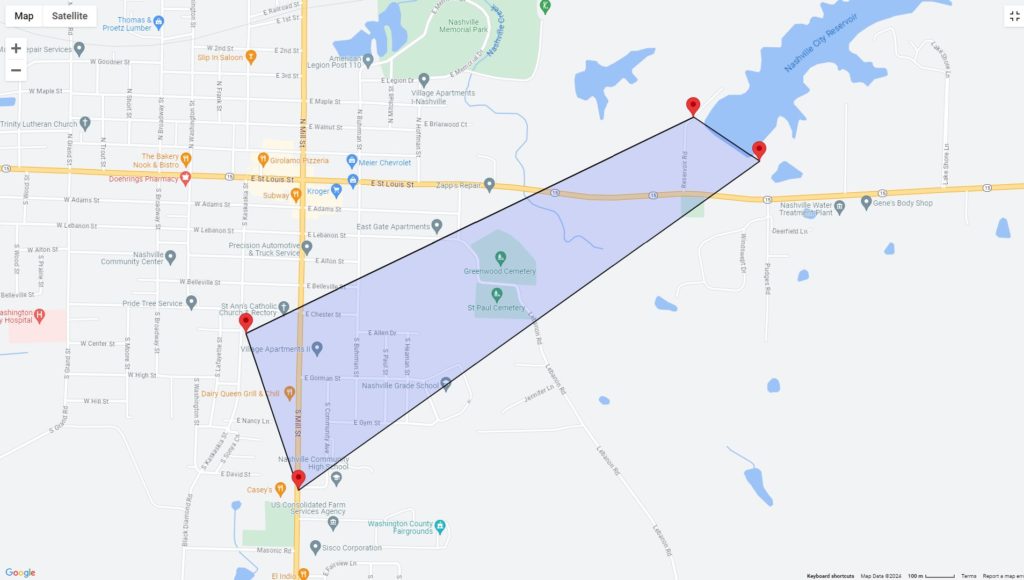
MOLLY PARKER
& BETH HUNDSDORFER
Capitol News Illinois
news@capitolnewsillinois.com
Two days of heavy rainfall caused water to overflow and breach the dams of Nashville’s city reservoir on Tuesday, resulting in extensive flooding and the evacuation of about 200 people from their homes in the small southern Illinois town of about 3,000 residents.
Initially described as a dam failure by local officials, spokespeople for the Illinois Department of Natural Resources and the Washington County Emergency Management Agency later clarified that the dam system operated “as designed” for flooding scenarios.
The 90-year-old city reservoir, which provides Nashville’s drinking water, includes a main dam with a spillway and a secondary earthworks dam. The design allows water to breach the secondary dam, diverting overflow to protect the main dam, said Alex Haglund, a spokesperson for the Washington County Emergency Management Agency. The “fuse plug” spillway that activates during high water levels directs water along a designated emergency path, IDNR added.
First responders oversaw the evacuation of residents from this designated pathway without incident; as of Tuesday afternoon, there had been no reported injuries from the breach of the dams, Haglund said.
Everyone was able to leave their homes unassisted except for one woman who was rescued by first responders. Home damage, however, appeared to be extensive in the pathway and in some adjacent neighborhoods, with some residents reporting waist-high water in their homes, Haglund said. Photos posted to Facebook by residents also showed flooded yards and partially submerged cars.
Haglund said it was unclear when residents would be able to return to their homes. The Red Cross is assisting those who were displaced.
Several roadways in and around Nashville were closed, though most of those closures were attributed to flash flooding from the heavy rainfall unrelated to the breach of the dams, Haglund said. He stressed that people should stay off the roads because it can be hard to assess the water’s depth.
Interstate 64 between Okawville and Richview remained closed late Tuesday afternoon, as well as state routes in and around Washington and St. Clair counties.
Haglund said first responders from neighboring communities and the Illinois Emergency Management Agency assisted the town after the emergency plan was initiated on Tuesday morning. As the flooding made headlines across the country, including reports in CNN and the New York Times, Haglund said the office also received calls expressing concern and support from state and federal officials, including a representative of the White House.
Haglund said the calls were appreciated, though Nashville has faced this issue before. The dams were similarly breached in 2022.
Long-term strategies to mitigate reservoir flooding remain uncertain, with Illinois House Rep. Charlie Meier, who represents the region, saying in an interview with a St. Louis-based TV news station on Tuesday that changes may be needed to better handle heavy rainfall.
The IDNR’s Office of Water Resources oversees nearly 2,000 public and privately owned dams in Illinois through its Division of Dam Safety, including approximately 250 categorized as “high-hazard potential” like the Nashville reservoir’s, according to a 2023 report by the Association of State Dam Safety Officials.
High-hazard potential dams are those whose failure could cause loss of life and significant property damage; they are required to undergo regular state inspections. Jayette Bolinski, IDNR spokesperson, said the dam system underwent its last inspection in November 2023, with no significant concerns found.
Flooding issues were widespread throughout the southwest region of the state.
In neighboring St. Clair County, county board chair Mark Kern declared the county a disaster area around noon on Tuesday after a phone call with Gov. JB Pritzker, according to St. Clair County Emergency Management Director Herb Simmons.
The disaster proclamation allows more access to help from state and federal agencies, Simmons said. St. Clair Emergency Management was awaiting pumps from the Illinois Department of Transportation late Tuesday afternoon.
More than 30 homes were evacuated in Cahokia Heights and East St. Louis on Tuesday. There have been several water rescues after drivers got stuck in water-covered roadways, Simmons said.
In Belleville, high waters forced the evacuation of the St. Clair County Animal Control. Workers carried or guided the cats and dogs housed there through waist-high water to evacuate the animals. Dogs were transferred to Gateway Pet Guardians in East St. Louis and St. Clair County Humane Society.
All the animals were rescued, including 21 cats and 40 dogs.
Capitol News Illinois is a nonprofit, nonpartisan news service covering government. It is distributed to hundreds of newspapers, radio and TV stations statewide. It is funded primarily by the Illinois Press Foundation and the Robert R. McCormick Foundation, along with major contributions from the Illinois Broadcasters Foundation and Southern Illinois Editorial Association.









